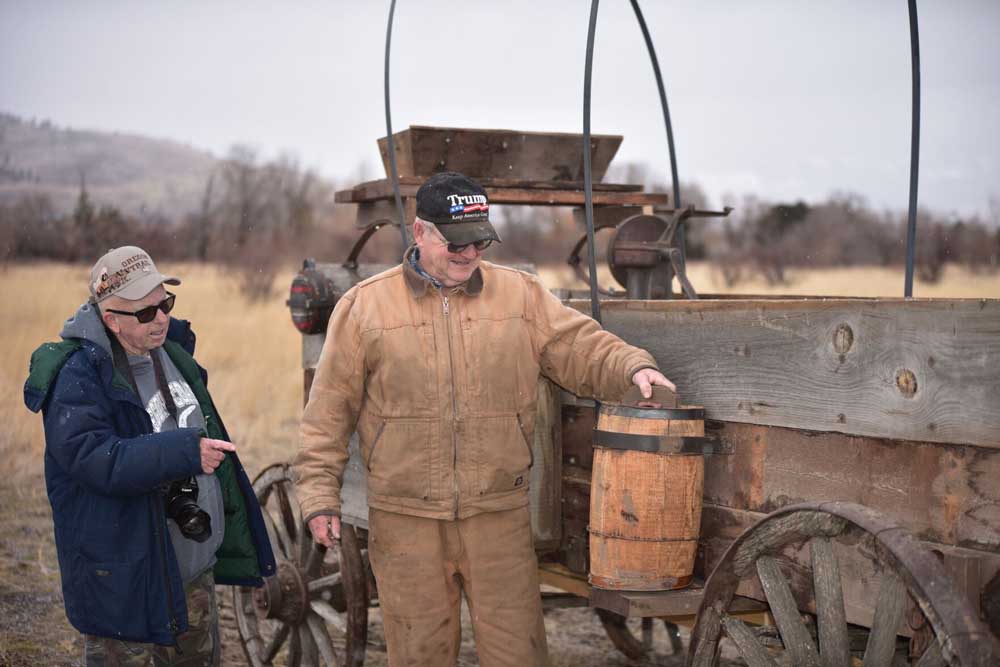Keeping the legacy of Oregon TraiI pioneer alive
Published 7:00 am Tuesday, January 17, 2023

- Ronnie Allen, left, and Dale Counsell talk on Monday, Feb. 8, 2021, next to a 120-year-old wagon they restored to resemble those the pioneers used while coming across the Oregon Trail in the 1800s. Allen provided the materials, and Counsell did the labor.
The National Historic Oregon Trail Interpretive Center near Baker City will soon receive a message from the future.
Its author will be La Grande historian Ronnie Allen.
Allen will soon prepare a letter that will be sent to the Oregon Trail Interpretive Center discussing the time capsule in a stone marker the legendary pioneer Ezra Meeker installed in 1906 on Walnut Street in La Grande. The marker’s time capsule was filled with items after being opened last summer and then sealed again.
A silver 2022 Ezra Meeker necklace medallion is one of the items in the time capsule. Allen is making arrangements, in part through his letter, to have the Meeker medallion sent to the Oregon Trail Interpretive Center after the time capsule is opened.
“I will ask that it be added to the Ezra Meeker display,” Allen said.
The time capsule will likely be opened about a century from now because Allen, with help from the Oregon-California Trails Association, which he is a member of, is making plans to have the time capsule sealed until at least 2122.
“We do not want it to be opened for 100 years,” said Allen, who is working closely on the project with his good friend, Dale Counsell, of La Grande.
The time capsule was opened last summer at a public event attended by about 150 people, however, it proved to be barren.
The marker’s time capsule space was believed to have contents in 1906, according to a Meeker journal entry. Allen said it was empty, probably because the marker reportedly had been moved several times in the Walnut Street neighborhood since it was first installed because of building projects. He said during the transfers the contents of the time capsule may have fallen out.
It is unlikely the marker will ever be moved again because in August a concrete form for the base of the stone Oregon Trail marker was added.
“Nobody would ever break into it because they would now have more than 1,000 pounds of concrete to deal with,” Allen said.
The concrete was poured as a public service by Steve Witty, of Cove, the owner of Witty’s Concrete, who donated not only his time but also all the resources needed for the project.
The stone marker is among at least 35 Meeker set up along the Oregon Trail during the three journeys he made across the United States to promote efforts to preserve the overland route. It was one of three Meeker put up in Union County. The two others were installed at the lower and upper ends of Ladd Canyon.
The marker at lower Ladd Canyon is now at the National History Oregon Trail Interpretive Center which is currently closed for renovation work. The upper Ladd Canyon marker has disappeared but Allen said he has been searching for it for years and has not given up in his pursuit of it.
Allen recently had a sample rock from the Walnut Street marker sent to Washington State University’s geology department to determine its content. Allen received a report nine months later, on Friday, Jan. 13, from WSU, one indicating that stone is made of basalt.
Allen said it is made from the same basalt the Meeker stone at the Oregon Trail Interpretive Center is made of. Allen said two years ago he had a sample from it also analyzed by WSU.
“They were both made from the same rock,” he said.
Allen worked through Jason McClaughry, a geologist with the Department of Geology and Mineral Industries in Baker City, to get the stone samples tested. McClaughry, after receiving the test results, determined that the stone for both markers came from a field about 4 miles west of La Grande in the Strawberry Mountain area.






